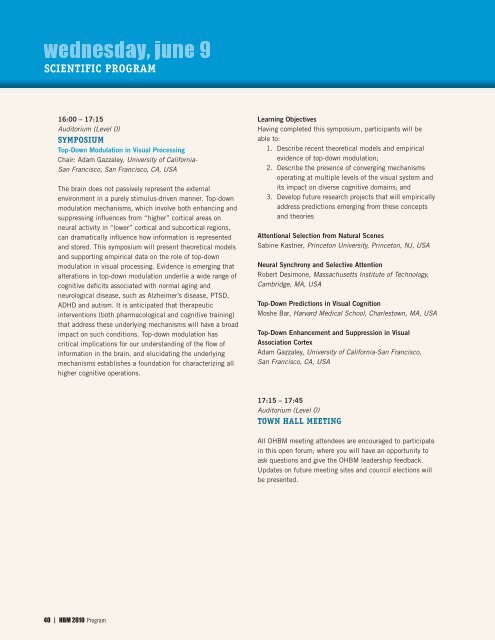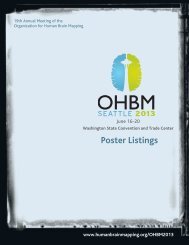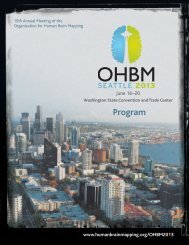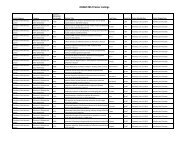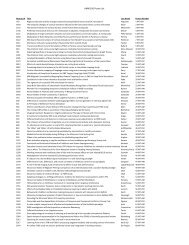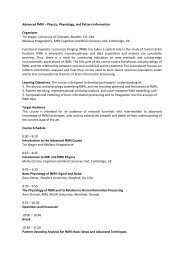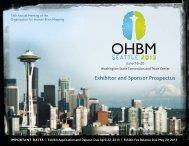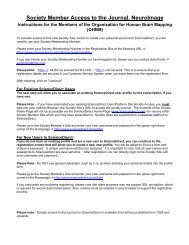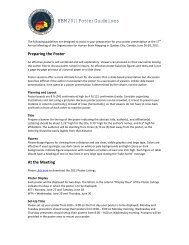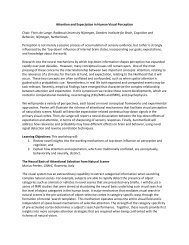HBM2010 - Organization for Human Brain Mapping
HBM2010 - Organization for Human Brain Mapping
HBM2010 - Organization for Human Brain Mapping
Create successful ePaper yourself
Turn your PDF publications into a flip-book with our unique Google optimized e-Paper software.
SCIENTIFIC PROGRAM<br />
16:00 – 17:15<br />
Auditorium (Level 0)<br />
SYMPOSIUM<br />
Top-Down Modulation in Visual Processing<br />
Chair: Adam Gazzaley, University of Cali<strong>for</strong>nia-<br />
San Francisco, San Francisco, CA, USA<br />
The brain does not passively represent the external<br />
environment in a purely stimulus-driven manner. Top-down<br />
modulation mechanisms, which involve both enhancing and<br />
suppressing influences from “higher” cortical areas on<br />
neural activity in “lower” cortical and subcortical regions,<br />
can dramatically influence how in<strong>for</strong>mation is represented<br />
and stored. This symposium will present theoretical models<br />
and supporting empirical data on the role of top-down<br />
modulation in visual processing. Evidence is emerging that<br />
alterations in top-down modulation underlie a wide range of<br />
cognitive deficits associated with normal aging and<br />
neurological disease, such as Alzheimer’s disease, PTSD,<br />
ADHD and autism. It is anticipated that therapeutic<br />
interventions (both pharmacological and cognitive training)<br />
that address these underlying mechanisms will have a broad<br />
impact on such conditions. Top-down modulation has<br />
critical implications <strong>for</strong> our understanding of the flow of<br />
in<strong>for</strong>mation in the brain, and elucidating the underlying<br />
mechanisms establishes a foundation <strong>for</strong> characterizing all<br />
higher cognitive operations.<br />
Learning Objectives<br />
Having completed this symposium, participants will be<br />
able to:<br />
1. Describe recent theoretical models and empirical<br />
evidence of top-down modulation;<br />
2. Describe the presence of converging mechanisms<br />
operating at multiple levels of the visual system and<br />
its impact on diverse cognitive domains; and<br />
3. Develop future research projects that will empirically<br />
address predictions emerging from these concepts<br />
and theories<br />
Attentional Selection from Natural Scenes<br />
Sabine Kastner, Princeton University, Princeton, NJ, USA<br />
Neural Synchrony and Selective Attention<br />
Robert Desimone, Massachusetts Institute of Technology,<br />
Cambridge, MA, USA<br />
Top-Down Predictions in Visual Cognition<br />
Moshe Bar, Harvard Medical School, Charlestown, MA, USA<br />
Top-Down Enhancement and Suppression in Visual<br />
Association Cortex<br />
Adam Gazzaley, University of Cali<strong>for</strong>nia-San Francisco,<br />
San Francisco, CA, USA<br />
17:15 – 17:45<br />
Auditorium (Level 0)<br />
TOWN HALL MEETING<br />
All OHBM meeting attendees are encouraged to participate<br />
in this open <strong>for</strong>um; where you will have an opportunity to<br />
ask questions and give the OHBM leadership feedback.<br />
Updates on future meeting sites and council elections will<br />
be presented.<br />
40 | HBM 2010 Program


